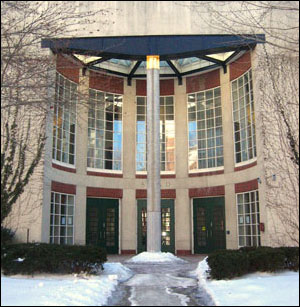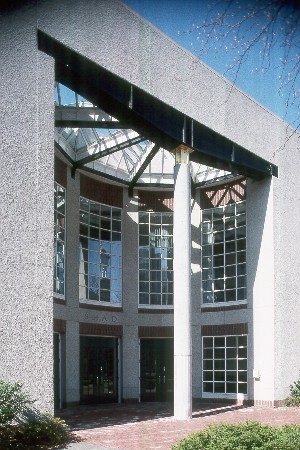The Collective Stupidity: Architecture as Prophecy
by Peter Walsh
“Architecture is to make us know and remember who we are.”
—Sir Geoffrey Jellicoe (1989)

Harvard University’s Shad Hall: Can a building predict the future?
Twenty years ago, the completion of Shad Hall, on the Harvard Business School campus, created a stir. Even for Harvard, the place was shrouded in deep secrecy. Access to the building, a large gymnasium, was restricted to the Business School’s faculty and students. Even the undergraduates at Harvard College were banned from its doors.
The exclusionary policy violated a long-standing, though informal, university tradition that gave access to gymnasiums, libraries, and other resources to all members of the larger Harvard community, no matter what their specific school or division might be. In recent years, though, the B-School, as it is known around Cambridge, had increasingly treated the rest of Harvard, let alone the world outside it, as the great unwashed masses.
Isolated on its own extensive grounds on the Boston side of the Charles River with its own dormitories, classrooms, library, and faculty club, the B-School seemed to enjoy snubbing its gilded nose at the rest of the world.
Shad Hall stands directly across the street from Harvard’s main athletic complex, which includes Harvard stadium, playing fields, a pool, indoor and outdoor tracks, a skating rink, weight rooms, and other facilities used by the entire university. The B-School gym was only a short walk from another complex, originally known as the Indoor Athletic Building, that served the center of the Harvard campus.
At the time, some of us Harvard types grumbled that Shad was a typical waste of the B-School’s resources. Shielded from the rest of the university’s less ample finances by the long-standing “every tub on its own bottom” policy, the school could do pretty much as it wished with the contents of its coffers, swelled to bursting with donations from wealthy alums. The free-market principle dictated that every part of the university fund itself. It created a system of poor Harvard cousins (the museums, the Ed School, the Divinity School) and rich Harvard uncles, the B-School first among them.
We also wondered why the B-School wanted to cut it off its students in this way. Harvard’s other gymnasiums are used by students and professors in dozens of fields, including politics, government, education, economics, history, design, and scholarship. Not a few of them end up as leaders and influential thinkers around the globe.
Drop in to a casual game of pick-up basketball on the central campus and you might meet, in embryonic form, a future Nigerian cabinet minister, the founder of a leading technology company, a Polish entrepreneur, the head of an Asian university, director of a major art museum or non-profit theatre— perhaps even the 44th President of the United States— a student at Harvard Law School, it happens, the very year Shad Hall opened.
Why, we asked, would the B-School want to protect its students from opportunities like these? After all, these were exactly the sorts of contacts that Harvard alums, traditionally, have valued above everything else in their student years.
Most mysteriously of all, when Shad opened all those years ago, the B-School not only spurned even casual visits from the rest of the university, it banned every outsider from entering its doors, not excluding architecture critics, and especially anyone with a camera. The school’s administration refused to release any photographs of the interior of the building, despite the fact that it was designed by one of Boston’s most distinguished architectural firms, award-winning Kallman, McKinnell, and Woods, best known as the architects of Boston’s late modernist City Hall.
Piqued by all the secrecy, undergraduate Harvard reporters and photographers snuck into the building and brought back the evidence. The guilty secret the school was trying to hide was its opulence, a splendor worthy of Rome at its most sybaritic— individual marble dressing rooms, gilded architectural details, glass atriums, an oak-paneled pub, and other indulgences, perks and luxury touches quite beyond Shad’s mundane function as a fitness center.
Years later, The Harbus, a B-School student weekly, no longer shy about Shad Hall’s elegant features, described the building as “massive” and “extravagant,” well suited to “one of the world’s richest and most prestigious business schools.”
“The building is magnificently posh, luxurious, lavish, and monstrous,” wrote contributing writer Brenda Vongova in 2007. “Every amenity imaginable is offered, including hot tubs and saunas. In terms of functionality, the structure of the building is nearly perfect. Its architect placed immeasurable thought and creativity into every possible detail.”
Flash ahead to January 2009. The 44th President and members of the U.S. Congress are outraged that executives at Wall Street firms, rescued from certain oblivion by tens of billions in tax-payer money, had just given themselves multi-million dollar bonuses. After presiding over one of the most disastrous years in Wall Street history, these same executives rewarded themselves with lavish golden parachutes, continued expensive sports sponsorships, and entertained sales staff and clients at posh, exclusive resorts.

Is Shad Hall destined to be a memorial to yet another vanished age of empire?
Most egregiously symbolic of all were the top brass of Citigroup who, reduced to government-dependent welfare queens by their own bungling, had just bought themselves a brand-new, $50 million corporate jet (since returned). Hadn’t they learned anything from the auto industry?
By what perverted sense of justice did these executives feel they were owed such things? Washington wondered. “They are kicking sand in the face of American taxpayers,” shouted Senator Claire McCaskell of Missouri on the Senate floor. “What planet are they from?”
What gym to they go to, the Senator might have asked, or what restaurants do they dine at, off-shore accounts do they sock their bonuses into, or luxury condos and country estates do they inhabit? What habits of privilege and entitlement did they learn in their college years? What lengths have they taken to isolate themselves from the daily lives of the rest of us, their depositors, investors, and customers?
As the walls of their paper empires crashed around them, were these corporate Caesars bent, above all, on preserving their own cosseted world of perks, privileges, and obscene wealth? Had Shag Hall predicted a world of luxurious, hidden splendor that business leaders could no longer bear to leave, even at the cost of their corporate lives?
During the illusory boom years, economist Jeff Madrick writes in The New York Review of Books, a focus on short-term profits “which made possible disproportionately large annual bonuses” strongly encouraged Wall Street executives to put their personal financial benefit over the long-term heath of their employers. Such incentives “were among the main causes of the irresponsibility on Wall Street.” Now the 44th president, once himself barred from the doors of Shad Hall, wants to do away with all that— limiting executives living off taxpayer handouts to a mere half million a year.
Modern archaeologists now believe that the Romans couldn’t really afford all those splendid buildings they built across their empire. All those temples, basilicas, theatres, amphitheatres, and marble-cased public bath houses, they say, were funded from the plunder seized by a rapidly expanding empire. Once the empire trembled and shrank from barbarian assaults, though, these grand buildings became white elephants, often pulled down to build the walls protecting their threatened cites.
Even in their ruined state, though, these ancient monuments are our most vivid reminder of what the Romans once were, power, brilliance, greed, arrogance, and cruelty alike.
Is Shad Hall destined to be a memorial to yet another vanished age of empire?
Tagged: Featured, Shad-Hall, The-Collective-Stupidity, harvard-university, peter-Walsh

Very good article! The culture of pseudo-liberal plutocratic greed that Harvard engendered – and which still, of course, thrives there – seems to have reached a level close to madness in the culture at large. I was amused to compare your description of the “individual marble dressing rooms, gilded architectural details, glass atriums, and oak-paneled pub” at Shad with recent press revelations regarding the corporate jet owned by Citigroup – it included “a full bar, $13,000 carpets, Baccarat crystal glasses, Cristofle sterling silver flatware and pillows made from Hermès scarves.” Of course the fact that Citigroup is on the public dole only reminds one that Harvard is, too – even if the august governors of the B-school seem to have forgotten this long ago. (And good point about Rome, too!)
Many thanks for the postive comments (and the luxury details about the plane), though I wouldn’t necessarily tar the rest of Harvard (or even all of the B-School) with the same brush. It is not always clear to me whether Harvard drives the trend or the trend drives Harvard, though in the case of Shad Hall, there is evidence of some serious pedagogic dysfunction. Not all teaching, Harvard should know, goes on in the classroom.
Well, perhaps there’s some department at Harvard that has taken a vow of poverty, but if so, I’m not aware of it. The digs everywhere are pretty luxe, you have to admit – not quite worthy of Caligula or Nero, like the B-school, but definitely decadent all the same. And there’s certainly an atmosphere of “deniable” greed about the place, as there is all over the Ivy League.